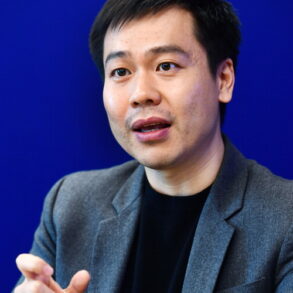
A new paper summarizing decades of research demonstrates how social media has supported an explosion of diversity in gender and sexuality in America during the 21st Century, and also how these technologies have equally enabled a cultural backlash.
The paper’s authors, UC Santa Cruz Psychology Professors Phil Hammack and Adriana Manago, identified five main narratives about gender and sexuality that they believe emerged through social media as people have strived to be “authentic” on these platforms. The findings, along with resulting recommendations for psychology researchers and practitioners, were published in American Psychologist, the flagship research journal of the American Psychological Association.
Since its inception, social media has essentially reversed the flow of information in American society, challenging traditional sources of authority and empowering individuals to create and share information for themselves, the paper says. The formats and customs of social media especially encourage self-expression and “authenticity,” or sharing your inner experience. Online connectivity also removes geographic barriers to finding other like-minded individuals.
Together, these conditions set the stage perfectly for new cultural norms to emerge, the paper’s authors argue. Manago, an expert in how communication technology shapes human development, explained that the team’s theory runs directly counter to “social contagion theory.”
“We’ve seen so much change so quickly in things like pronouns and sexual orientation that people have been hungry for an explanation, and as a result, social contagion theory is this very harmful idea that has become popular, despite not being backed by good evidence,” she said.
“Social contagion theory argues that adolescents are going online and seeing that expressing yourself as having an LGBTQ+ identity is cool and popular, so they are conforming to a popular notion outside of themselves,” Manago continued. “Our paper argues the opposite. The diversity that we’re seeing now was always there, but the dominant cultural paradigms previously masked it. Now, new communications tools are bringing it to light by promoting and enabling authenticity.”
New cultural narratives of gender and sexuality
Among the new cultural narratives that researchers say have emerged from online authenticity is the concept of gender as self-constructed, meaning that there can be a difference between sex assigned at birth and a person’s gender identity or expression. For example, research shows that Tumblr blogs have helped transgender people navigate the gender affirmation process, and TikTok has become a central resource for youth who are questioning their own gender or sexuality to explore identities and connect with others.
Hammack, an expert on generational differences in gender and sexuality, emphasizes that people are using social media as a tool to better understand complexities around gender identity that they already feel within themselves.
“We have to remember that, with social media, an algorithm responds to the person,” he said. “So if you’re starting to question your gender, you’re going to look for related content, and then the algorithm affirms that, but you are still the active agent who is on social media liking things. That agency sometimes gets downplayed when we talk about the influence of social media.”
Another narrative that has gained traction on social media is the idea that sexuality is plural, playful, flexible, and fluid. One aspect of this is the possibility for attraction to multiple genders. For example, research that used the Craigslist personals section to recruit participants has bolstered new understandings of bisexuality among men and has also shown that some people who identify as straight still seek same-sex contact. Meanwhile, Tumblr helped to popularize the pansexual identity. And new social networking websites for people with fetishes have increased acceptance of a wider variety of sexual practices.
Some modern online narratives also present sexuality and monogamy as cultural compulsions, rather than biological ones. For example, asexuality has become an accepted identity for those who feel little or no sexual attraction, with help from a website that challenged traditional pathologizing views. And new dating apps have been developed specifically to support forms of consensual nonmonogamy that are gaining public visibility.
Intersectionality has become a key part of many online narratives too, such as the #SayHerName campaign on Twitter, which sought to draw attention to state-sanctioned violence against Black cisgender and transgender women alike. New terminologies and forms of identity have also developed on Tumblr that increasingly recognize how gender and sexuality intersect with each other, and these concepts have spilled over onto platforms like Twitter, now called X, and TikTok.
But not all online narratives that seek to convey authenticity in gender and sexuality promote diversity. A transphobic, homophobic, and misogynistic backlash has also spread through social media technology, sometimes resulting in real-world violence. One example is how Reddit and TikTok have spread “incel” or “involuntary celibate” ideology that views both women’s equality and sexual and gender diversity as threats to masculinity.
“These reactionary forces that are being destabilized from their dominant position in society are also using authenticity narratives about being a ‘real man’ to spread their views, and they’re claiming that all of these other narratives are false,” Manago explained. “So authenticity is a central concept in all of the narratives on gender and sexuality that we see emerge through these platforms, regardless of whether they’re progressive or regressive.”
Recommendations for psychologists
Based on their findings, the paper’s authors offer several recommendations. Psychology researchers and practitioners should start by grounding their work in people’s lived experiences, the paper says. That could include counselors making sure they stay up to date on new popular terminology around gender and sexuality and researchers asking more open-ended questions and offering write-in options for collecting information about gender and sexuality.
The team also recommends approaching emerging forms of identity with affirmation, rather than suspicion and focusing on the phenomena of sexual and gender diversity more so than individual identity labels, which inevitably always leave someone out. The paper advises that social change on these issues is fluid and nonlinear, and the current context is not necessarily one of “achievement” for rights and recognition, as evidenced by regressive authenticity narratives that have spread alongside progressive ones.
Hammack and Manago ultimately encourage psychologists to continue challenging normative thinking, both around sexuality and gender and around social media’s role in identity formation. They say social media is neither a source of youth corruption nor a cure-all for advancing acceptance and equity. Instead, meaningful cultural change that starts on social media should result in new resources and support in our geographic communities.
“If community spaces and educational spaces don’t keep pace with these changes, that can become dangerous, because young people will continue to turn to social media, and they may lose confidence in other sources of authority, like teachers and parents, who they see as being socially behind the times,” Hammack said. “As adults, the responsible thing is for us to acknowledge that we live in a time of great change on gender and sexuality and to find ways to integrate new perspectives into education, our communities, and our families, so that young people don’t experience isolation and don’t lose confidence in us.”
This post was originally published on this site be sure to check out more of their content







